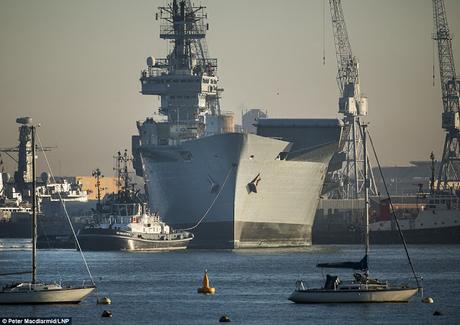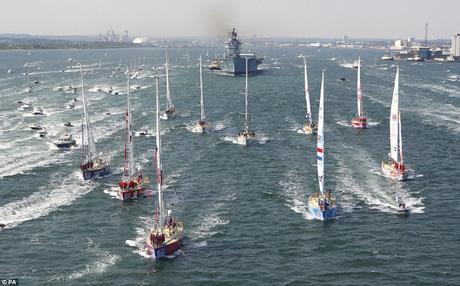They are taken to on a funeral voyage to the junk-yard – with high tide, they are simply intentionally run aground, as closer to the shore as possible, then cruelly cut into pieces manually, pulled a bit more, and eventually even the keel vanishes !!

Now it is the turn of ‘HMS Illustrious’, which served in the Falklands War, the Gulf War and Bosnia, to be scrapped on Wednesday. It will leave its base at Portsmouth and head to Turkey where it has been sold for £2million. Daily Mail reports that the last of the Invincible-class aircraft carriers, which could be armed with Harrier jets and attack helicopters, was retired in 2014 after entering service in 1982. The ship's final years have been controversial after the Ministry of Defence declined plans to preserve her as a naval museum. A last ditch attempt to save her from scrap was refused by naval bosses despite £3million being offered. HMS Illustrious will make way for for two new Queen Elizabeth-class carriers, the first of which will be commissioned for military operations in 2020. The MoD expects the carrier to leave Portsmouth for Leyal Ship Recycling and Dismantling company in Aliaga, Turkey, on Wednesday depending on weather conditions. It is the same yard which scrapped her sister ships Ark Royal and Invincible. HMS Ark Royal was scrapped for £2.9 million in 2013 and HMS Invincible fetched around £2 million in 2011.
 It is not
alone nor the first ship. Five other
Navy ships have borne the name Illustrious. The first won battle honours
alongside Horatio Nelson’s gunship to secure victory over the French in the
1795 battle of Genoa. The current Illustrious was built by Swan Hunter
shipyards, Tyne and Wear, and commissioned ahead of schedule in 1982 to allow
to serve in the Falklands War. In 1986 she suffered a catastrophic gearbox
failure and was swept by a major fire – almost prompting a call to abandon ship
– that put her out of action for several months of repairs. She has sailed
898,893 miles, equivalent to 36 times around the equator. She was also involved
in efforts to distribute relief in the wake of Typhoon Haiyan in the Philippines
in 2013.
Veterans who
sailed on Illustrious viewed her demise as sad but inevitable. Speaking earlier
this year, David Rogers, vice chairman of the HMS Illustrious Association,
said: ‘We’re all very sad it’s come to this obviously, but I think it was an
inevitability. ‘The ship was conditioned in 1982. She was probably only
designed to last 20 years and she did another 12 years after that.' The ship,
nicknamed ‘Lusty’, has been moored in Portsmouth since she was decommissioned
in a moving ceremony in the city on August 28, 2014.
I had always
thought that only ships had funeral voyage – it appears that ship-breaking
yards too are headed for swan song. The Indian
town of Alang, which was considered one of the biggest ship recycling centre,
where workers with blow torches cut segments of steel stripped from the rusting
hull of a towering cargo ship – are hit reportedly by a flood of cheap Chinese steel and new
European Union environmental rules – is the business dying is the Q ? as the
buzzing town is slowly losing its prominence. The plunging steel prices has
contributed a lot to this.
The Marine Hull Tariff provided ways of covering these ‘
dying ships ‘ under two different sections. Sec V of the erstwhile Marine Hull
Tariff provided for coverage of funeral voyages from a place in a Port to the
breakup yard or vessels lying at sheltered places awaiting break up. This was
more of transit insurance and would cease upon beaching or starting up of
breaking operations. Another Section provided for Ship breaking insurance –
insurance of vessels in the course of being broken up. Here the Sum insured was
to be Full purchase price + customs duty + port charges + any other government
levy. The period was not on voyage basis but was to be reckoned in period of
full months, arrived at the basis of actual LDT of the vessel. The policy
though issued in Hull Department was more or less Fire Policy ‘C’ cover
providing coverage against Fire, Lightning, Explosion / Implosion, Impact
damage, Aircraft damage, Riot, strike, malicious damage and additional cover
against Earthquake, STFI perils etc.,
It is not
alone nor the first ship. Five other
Navy ships have borne the name Illustrious. The first won battle honours
alongside Horatio Nelson’s gunship to secure victory over the French in the
1795 battle of Genoa. The current Illustrious was built by Swan Hunter
shipyards, Tyne and Wear, and commissioned ahead of schedule in 1982 to allow
to serve in the Falklands War. In 1986 she suffered a catastrophic gearbox
failure and was swept by a major fire – almost prompting a call to abandon ship
– that put her out of action for several months of repairs. She has sailed
898,893 miles, equivalent to 36 times around the equator. She was also involved
in efforts to distribute relief in the wake of Typhoon Haiyan in the Philippines
in 2013.
Veterans who
sailed on Illustrious viewed her demise as sad but inevitable. Speaking earlier
this year, David Rogers, vice chairman of the HMS Illustrious Association,
said: ‘We’re all very sad it’s come to this obviously, but I think it was an
inevitability. ‘The ship was conditioned in 1982. She was probably only
designed to last 20 years and she did another 12 years after that.' The ship,
nicknamed ‘Lusty’, has been moored in Portsmouth since she was decommissioned
in a moving ceremony in the city on August 28, 2014.
I had always
thought that only ships had funeral voyage – it appears that ship-breaking
yards too are headed for swan song. The Indian
town of Alang, which was considered one of the biggest ship recycling centre,
where workers with blow torches cut segments of steel stripped from the rusting
hull of a towering cargo ship – are hit reportedly by a flood of cheap Chinese steel and new
European Union environmental rules – is the business dying is the Q ? as the
buzzing town is slowly losing its prominence. The plunging steel prices has
contributed a lot to this.
The Marine Hull Tariff provided ways of covering these ‘
dying ships ‘ under two different sections. Sec V of the erstwhile Marine Hull
Tariff provided for coverage of funeral voyages from a place in a Port to the
breakup yard or vessels lying at sheltered places awaiting break up. This was
more of transit insurance and would cease upon beaching or starting up of
breaking operations. Another Section provided for Ship breaking insurance –
insurance of vessels in the course of being broken up. Here the Sum insured was
to be Full purchase price + customs duty + port charges + any other government
levy. The period was not on voyage basis but was to be reckoned in period of
full months, arrived at the basis of actual LDT of the vessel. The policy
though issued in Hull Department was more or less Fire Policy ‘C’ cover
providing coverage against Fire, Lightning, Explosion / Implosion, Impact
damage, Aircraft damage, Riot, strike, malicious damage and additional cover
against Earthquake, STFI perils etc.,
With regards – S. Sampathkumar 2nd Dec 2016.
Credits : Photos and news of HMS Illustrious – dailymail.co.uk.

